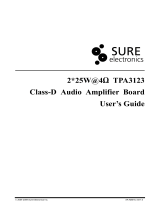
SERVICE MANUAL
Sony Corporation
Published by Sony Techno Create Corporation
HT-CT180
SA-CT180
SPECIFICATIONS
HT-CT180
SOUND BAR
SA-CT180
ACTIVE SPEAKER SYSTEM
9-896-127-01
2015B33-1
©
2015.02
US Model
Canadian Model
AEP Model
UK Model
Australian Model
Ver. 1.0 2015.02
• All of the units included in the HT-CT180
(SA-CT180/SA-WCT180/Remote control)
are required to confi rming operation
of SA-CT180. Check in advance that
you have all of the units.
COMPONENT MODEL NAME
HT-CT180
Bar Speaker (Active Speaker System) SA-CT180
Subwoofer (Active Subwoofer) SA-WCT180
Photo: SA-CT180
• Please refer to service manual separately issued for Subwoofer.
Amplier section
U.S. models:
POWER OUTPUT AND TOTAL HARMONIC
DISTORTION:
(FTC)
Front L + Front R:
With 4 ohms loads, both channels
driven, from 200 Hz - 20,000 Hz; rated
13 Watts per channel minimum RMS
power, with no more than 1% total
harmonic distortion from
250 milliwatts to rated output.
POWER OUTPUT (reference)
Front L/Front R speaker:
25 Watts (per channel at 4 ohms,
1kHz)
Except US models:
POWER OUTPUT (rated)
Front L + Front R:
13 W + 13 W (at 4 ohms, 1 kHz, 1% THD)
POWER OUTPUT (reference)
Front L/Front R speaker:
25 Watts (per channel at 4 ohms,
1kHz)
Inputs
OPTICAL
ANALOG
BLUETOOTH section
Communication system
BLUETOOTH Specication version 4.0
Output
BLUETOOTH Specication Power Class
2
Maximum communication range
Line of sight approx. 10 m (33 ft)
1)
Maximum number of devices to be
registered
8 devices
Frequency band
2.4 GHz band (2.4000 GHz -
2.4835 GHz)
Modulation method
FHSS (Freq Hopping Spread Spectrum)
Compatible BLUETOOTH proles
2)
A2DP (Advanced Audio Distribution
Prole)
Supported Codecs
3)
SBC
4)
Transmission range (A2DP)
20 Hz - 20,000 Hz (Sampling frequency
44.1 kHz)
1)
The actual range will vary depending on
factors such as obstacles between
devices, magnetic elds around a
microwave oven, static electricity,
cordless phone, reception sensitivity,
operating system, software application,
etc.
2)
BLUETOOTH standard proles indicate
the purpose of BLUETOOTH
communication between devices.
3)
Codec: Audio signal compression and
conversion format
4)
Subband Codec
Speakers
Front L/Front R speaker section
Speaker system
2-way speaker system, Acoustic
suspension
Speaker
Tweeter: 14 mm - 25 mm (
9
/
16
in - 1 in)
balance dome type
Woofer: 40 mm × 120 mm (1
5
/
8
in ×
4
3
/
4
in) cone type
General
Power requirements
Supplied accessories
Remote control (1)
Speaker pads for the subwoofer (4)
Optical digital cable (1)
R03 (size AAA) batteries (2)
120 V AC, 60 Hz (US and Canadian models)
220 V - 240 V AC, 50 Hz/60 Hz
(AEP, UK and Australian models)
Power consumption
On: 17 W
Standby mode: 0.5 W or less
BLUETOOTH Standby mode: 3 W or
less
Dimensions (approx.) (w/h/d)
901 mm × 52 mm × 84 mm
(35
1
/
2
in × 2
1
/
8
in × 3
3
/
8
in)
Mass (approx.)
2kg (4lb 7oz)
Frequency band
2.4 GHz band (2.404 GHz - 2.476 GHz)
Modulation method
GFSK
Design and specications are subject to
change without notice.
Wireless transmitter
Note:
Be sure to keep your PC used for service and
checking of this unit always updated with the
latest version of your anti-virus software.
In case a virus affected unit was found during
service, contact your Service Headquarters.






















